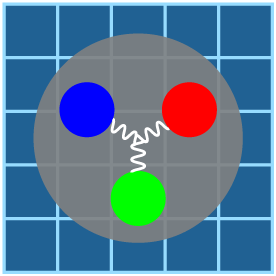The strong force, an undeniable cornerstone of the Standard Model of particle physics, is often likened to an invisible glue that binds the very fabric of matter. It is this force that governs the behavior of subatomic particles, particularly within atomic nuclei, where protons and neutrons cohabitate in an intricate dance, held together against the repulsive electromagnetic forces that naturally act between the positively charged protons. This seemingly paradoxical reality, where opposites attract and like charges endure a constant struggle, illustrates the profound complexity of the universe at its most fundamental level.
At the heart of this mystery lies the interaction mediated by particles known as gluons. These massless carriers of the strong force act as the emissaries of attraction, orchestrating a symphony of forces that dictate not only the stability of atomic nuclei but also the mechanisms of nucleosynthesis that forge new elements within the heart of stars. Gluons themselves do not exist in isolation; rather, they are perpetually in a state of transmission, conveying the force between quarks—the elementary constituents of protons and neutrons. Quarks come in six distinct flavors: up, down, charm, strange, top, and bottom, each possessing unique attributes and fractional electric charges.
Understanding the strong force requires delving into the realm of quantum chromodynamics (QCD), which is the theoretical framework that describes how quarks and gluons interact. The “color charge,” a property analogous to electric charge in electromagnetism, is ubiquitous in this context. Quarks possess one of three “colors”—red, green, or blue—while gluons carry a combination of color charges. This intricate color interplay ensures that isolated quarks cannot be found in nature; instead, they are eternally confined within larger particles, such as protons and neutrons, akin to the tightly-knit family structure in a communal society where the bonds among members are robust and inseparable.
A noteworthy phenomenon associated with the strong force is asymptotic freedom, a term that describes the peculiar behavior of quarks as they approach each other. As quarks get closer, the force between them diminishes, enabling them to behave almost as free particles when in close proximity. Fuelling this analogy is the notion of a stretchable rubber band that becomes less taut as one approaches the center. In contrast, at larger distances, the strong force behaves differently, increasing dramatically, thereby relegating quarks to a state of confinement. This duality exemplifies the intricate balance inherent within the strong force, which can be viewed as artfully orchestrated chaos.
The implications of the strong force extend beyond the bounds of mere stability in atomic structures. Its comprehension opens doors to our understanding of stellar processes, including the life cycles of stars and the origins of elements in the universe. During stellar nucleosynthesis, the conditions of extreme pressures and temperatures facilitate the fusion of lighter atomic nuclei into heavier elements, an endeavor made possible by the formidable strength of the strong force. It is through such processes that the universe expands its repertoire of elemental diversity, crafting the very building blocks of life as we know it.
Moreover, exploring the nuances of the strong force unveils the possibility of phenomena such as quark-gluon plasma, an exotic state of matter theorized to have existed shortly after the Big Bang. When subjected to sufficiently high temperatures and densities, quarks and gluons become decoupled from the confines of protons and neutrons, fluidly interacting in a primordial soup. This concept not only tantalizes theoretical physicists, but also challenges our perceptions of matter and forces, beckoning us to reinterpret foundational ideas about the formation of the cosmos.
The experimental pursuits to unravel the intricacies of the strong force have propelled forward significant advancements in both technology and knowledge. High-energy particle colliders, such as the Large Hadron Collider (LHC), serve as colossal laboratories where the dynamics of fundamental particles are probed with unprecedented precision. It is within these high-energy collisions that physicists observe the remnants of quark-gluon interactions, offering glimpses into the heart of the strong force and potentially revealing new physics beyond the established Standard Model.
Furthermore, as scientific inquiry continues to transcend traditional limits, theorists explore enigmatic questions surrounding confinement and the nature of mass itself. The Higgs mechanism, which endows particles with mass, finds its complement in the role of the strong force, intricately weaving a complex web that governs the stability and behavior of matter. Each revelation in particle interactions brings us one step closer to deciphering the fundamental principles that govern our universe.
In summation, the strong force stands as both a powerful adhesive and an intricate puzzle, binding the constituents of matter while simultaneously challenging our understanding of fundamental physics. It represents a compelling narrative of attraction, confinement, and complexity, echoing the divine symphony of the cosmos. As physicists continue to explore its depths, the allure of the strong force lies not only in its ability to sustain the building blocks of atoms but also in the myriad questions it raises about the very nature of reality. Each new discovery fuels an unquenchable curiosity, illuminating an enigmatic force that pervades existence, offering a glimpse into the profound interconnectedness of all things within the universe.












